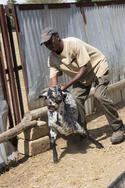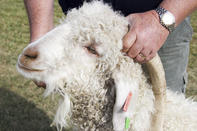
Goats need to be handled for tasks such as vaccinating, deworming, hoof trimming and sorting. A set of working pens will minimise stress and risk to both the animals and the farmer. Smallish pens and handling facilities allow for easier handling of the goats rather than trying to work with them in a large camp.
Goats are intelligent and can be more difficult to handle than cattle or sheep when using handling equipment. They do not ‘flow' as easily and tend to stress more readily. When frightened, they may pack together in a corner or lie down and sulk, but may also become aggressive toward each other.
The main thing to consider when handling goats is to keep them calm and prevent injuries. Work calmly and quietly with your goats, never force or probe them. No dropping, throwing, dragging of goats or pulling by their fleece, tail, ears, legs, head or neck are allowed. When handling goats, you need to understand their natural behaviour.
For example, they prefer to move towards light rather than dark. They do not like to enter dark buildings and are easily distracted by noise. Goats like to follow the leader and when in a pen, they tend to move in a circle around the handler. Goats also prefer to stay with the herd and will move in family groups, with older females moving first.
Separating them will cause stress. They can become aggressive when confined and stressed. This can cause them to jump and find gaps to escape. Be careful when handling male goats, as distressed bucks may cause injuries to you and your animals.
Livestock does not like to be driven in the dark and responds easier when a person stands behind their shoulder, but still in their field of vision. To get goats to move down a raceway (a narrow channel or chute e.g. near a loading dock), move fast, next to the raceway in the opposite direction to the goats; this will make them move forward up the raceway.
How to Hold a Goat

To catch a goat, quietly go to its side and catch it by the base of the horns or high on the hind leg, not on the ‘ankle’. Catch a young goat with one arm in front of the front legs and the other arm behind the back legs. Goats should not be dragged by their legs, their tails should not be lifted or twisted and they should not be moved by holding only the horns, ear or tail.
When you need to handle a goat, hold the base of the horns and not the tips. A goat should be handled with one hand or arm under the neck and the other around the rear. When a goat is ‘turned’ for examination of its abdomen, trimming hooves or shearing lift its left legs first.
The intestines will rotate in an anti-clockwise and will reduce the rare incidence of a ‘twisted gut’. (Looking from the tail of the goat, it should rotate in a clockwise direction.) When the goat is placed back on its feet from a ‘sitting’ position it must be rolled so its left feet touch the ground first. Never drag an animal by its legs, use a prodder or strike it in the face.
Handling Goats in the Field
In large fields, dogs (working wide from the stock) are very useful. The goats will cling together and start moving as soon as they become aware of the dog. Usually, this will mean they move quickly uphill. Goats will always move more quickly uphill than downhill.
It is difficult to move large herds downhill, especially when there are kids or weaners. They tend to break away across the side of a hill. Move slowly downhill. Only sticks with canvas or belting flaps may be used when driving animals.
Rather hit the ground than the animal itself. Animals moving on the hoof, should be driven at a relaxed pace, not faster than the slowest animal and not further than 20 km (on the first day) and not further than 15 km on subsequent days.
Transportation of Goats
Goats should have access to fresh food and water immediately before and after transportation. As goats become tamer, their recovery after being transported will improve. Sometimes goats can sulk and not eat after transportation. Goats which need to travel far need to be in good condition.
Vehicles for transportation of goats should have a non-slip floor (and bedding such as sawdust or straw), sides higher than 750 mm, with ventilation and light. Vehicles should not be completely closed. The truck needs to be covered with a tarpaulin to protect the animals from wind and rain, but there needs to be enough ventilation.
Do not park a truck longer than an hour without giving shade or ventilation. It is important to separate goats into small numbers on trucks to prevent injury and smothering. Separate horned and polled animals, males and females as well as large and small animals to prevent injury.
Blind animals should be clearly marked with a coloured circle around the blind eye and on both the rumps of the animal. They should be herded separately. Transportation and stress can expose underlying health problems. Goats may develop clinical symptoms of respiratory infections and pneumonia or parasites as a result of stress during handling.
When offloading, make sure to use a non-slip ramp and provide fresh water and food as soon as possible. Goats should not be dropped or jump from a vehicle from a height greater than 1.5 m.
By Marinda Louw